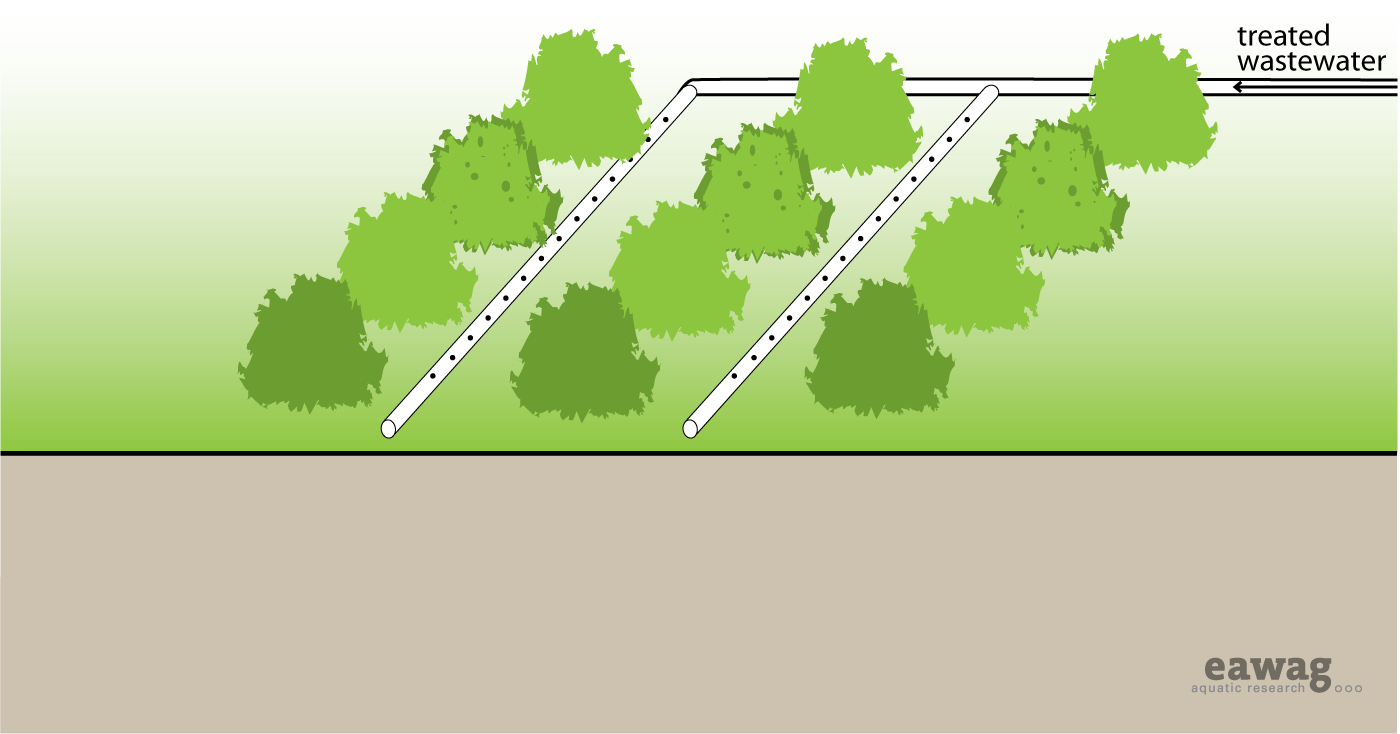Irrigation
|
|||||||||||||||||||||||||||
To reduce dependence on freshwater and maintain a constant source of irrigation water throughout the year, waste waters of varying qualities can be used in agriculture. Generally, only waters that have had secondary treatment (i.e. physical and biological treatment) should be used to limit the risk of crop contamination and the health risk to workers.
There are two kinds of irrigation technologies that are appropriate for using treated wastewaters:
1)Drip irrigation where the water is dripped slowly on or near the root area; and
2)Surface water irrigation where water is routed overland in a series of dug channels or furrows.
To minimize evaporation and contact with pathogens, spray irrigation should be avoided.
Properly treated wastewater can significantly reduce dependence on freshwater, and/or improve crop yields by supplying increased water and nutrients to plants. Raw sewage or untreated blackwater should not be used, and even well-treated water should be used with caution. Long-term use of poorly or improperly treated water may cause long-term damage to the soil structure and its ability to hold water.
| Advantages | Disadvantages/limitations |
|---|---|
| - Reduces depletion of ground water and improves availability of drinking water. - Reduced need for fertilizer. - Low to moderate capital cost; low to moderate operating cost. - Potential for local job creation and income generation. - Low risk of pathogen transmission if water is properly pre-treated. - Potential to improved health, self-reliance in community. |
- Must be well settled. - very sensitive to clogging. - May require expert design and installation. - Not all parts and materials may be available locally. |
Contents
Adequacy
Generally, drip irrigation is the most appropriate irrigation method; it is especially good for arid and drought prone areas. Surface irrigation is prone to large losses from evaporation but requires little/ no infrastructure and may be appropriate in some situations.
Crops such as corn, alfalfa (and other feed), fibres (cotton), trees, tobacco, fruit trees (mangos) and foods requiring processing (sugar beet) can be grown safely with treated effluent. More care should be taken when growing fruits and vegetables that may be eaten raw (e.g. tomatoes) that could come in contact with the water. Energy crops like eucalyptus, poplar, willow, or ash trees can be grown in short-rotation and harvested for biofuel production. Since the trees are not for consumption, this is a safe, efficient way of using lower quality effluent.
There are potential health risks if water is not properly pre-treated (i.e. inadequate pathogen reduction). Soil quality can be degraded over time (e.g. accumulation of salts) if poorly treated waste water is applied. The application rate must be appropriate for the soil, crop and climate, or it could be damaging.
Health Aspects/Acceptance
Appropriate pre-treatment should precede any irrigation scheme to limit health risks to those who come in contact with the water. As well, depending on the degree of treatment that the effluent has undergone, it may be contaminated with the different chemicals that are discharged into the system. When effluent is used for irrigation, households and industries connected to the system should be made aware of the products that are and are not appropriate for discharging into the system.
Drip irrigation is the only type of irrigation that should be used with edible crops, and even then, care should be taken to prevent workers and harvested crops from coming in contact with the treated effluent. Despite safety concerns, irrigation with effluent is an effective way to recycle nutrients and water.
Maintenance
Drip irrigation systems must be cleaned periodically to remove any built-up solids. The pipes should be checked for leaks as they are prone to damage from rodents and humans. Drip irrigation is more costly than conventional irrigation, but has improved yields and decreased water/ operating costs.
References
- Ayers, RS. and Westcot, DW. (1994). FAO Irrigation and Drainage Paper 29 Rev. 1. Water Quality for Agriculture. FAO, Rome.
- Crites, R. and Tchobanoglous, G. (1998). Small and Decentralized Wastewater Management Systems. WCB and McGraw-Hill, New York, USA. pp 878–886.
- Mara, DD. (1996). Low-Cost Urban Sanitation. Wiley, Chichester, UK. pp 150–152.
- Mara, DD. (2004). Domestic Wastewater Treatment in Developing Countries. Earthscan, London. pp 231–245.
- Okun, DA. and Ponghis, G. (1975). Community Wastewater Collection and Disposal. WHO, Geneva. pp 211–220.
- Sasse, L. (1998). DEWATS: Decentralised Wastewater Treatment in Developing Countries. BORDA, Bremen Overseas Research and Development Association, Bremen, Germany.
- WHO (2006). Guidelines for the safe use of wastewater, excreta and greywater- Volume 2: Wastewater and excreta use in agriculture. WHO, Geneva.
Acknowledgements
The material on this page was adapted from:
Elizabeth Tilley, Lukas Ulrich, Christoph Lüthi, Philippe Reymond and Christian Zurbrügg (2014). Compendium of Sanitation Systems and Technologies, published by Sandec, the Department of Water and Sanitation in Developing Countries of Eawag, the Swiss Federal Institute of Aquatic Science and Technology, Dübendorf, Switzerland.
The 2nd edition publication is available in English. French and Spanish are yet to come.

